Technical Data Coupling Handling
ECHT-FLEX Coupling NER Series Handling
This section describes the general handling procedures used for NER Series ECHT-FLEX Couplings. For more information, see the instruction manual provided with the product.
1. Installing hubs to the shafts
Notes
- ※1 Check the coupling components against the list of components in the instruction manual.
- ※2 The center unit has been optimally assembled at the factory. Use it as-is, without disassembling it.
- ※3 Do not subject the center unit to large forces, especially in the shaft direction. It may cause the disks in a bent state, and damage the disks.
Installing procedure
- (1) Check that the drive shaft, driven shaft and hub bores are free from burrs, scratches, dirt and rust. Wipe off any dirt or oil.
- (2) Mount the hubs to the shafts. If bore is for tight fit, heat the hub uniformly with heated oil (of 150°C or less) to quickly mount it at the proper position on the shaft.
- (3) The distance between the hub flange faces is given in Item (1) of Section 2 below.
2. Centering
The more accurate the initial centering of the coupling, the less eccentric rotational stress it will experience during operation.
Changes during operation caused by factors such as bearing wear, mounting surface subsidence, temperature-induced state changes, and vibrations can reduce the life of the coupling or your equipment.
Periodically center the coupling using the procedure below.

The error in the distance between the coupling’s flange faces, the allowable angular misalignment, and the parallel misalignment are all related to each other. Increasing one factor decreases the others, so the factors need to be considered together.
Perform the initial centering procedure precisely, to within the recommended centering values below.
(1) Adjusting the distance between the flange faces (J)
Measure the overall length of the center unit, and use this value as the J dimension.
(The center unit’s overall length may be longer or shorter than the reference value depending on the combination of part tolerances. In this case, it may be difficult to attach the center unit even when the hubs are set within J ± 0.5 mm in the drawing reference dimensions. )
Measure the J dimension at four places every 90 degrees, and adjust the hub positions so that the average of these measurements is within J ± 0.5 mm. If the drive shaft or driven shaft is a stepped shaft, the adjustment margin may be restricted, so take steps to enable the J dimension to be adjusted beforehand.
(2) Adjusting the angular misalignment (θ)
- (a)Fasten a dial gauge to one of the hubs as shown in the diagram. Rotate the hub to find the minimum reading on the dial gauge, and zero the gauge at that point.
- (b)Rotate the hub on the dial gauge side by 360 degrees, and read the angular misalignment value.
- (c)Adjust the equipment by moving it with a shim so that the reading on the dial gauge comes within the recommended angular misalignment range specified in Table 1.
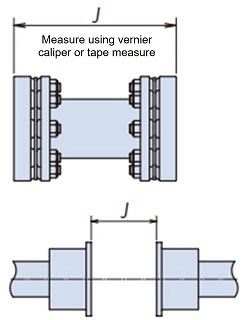
(3) Adjusting the parallel misalignment (ε)
- (a)Attach a dial gauge to a hub flange as shown in the diagram. Rotate that hub to find the minimum reading on the dial gauge, and zero the gauge at that point.
- (b)Rotate the hub attached to the dial gauge by 360 degrees, and read the parallel misalignment value.
- (c)The reading on the dial gauge around the periphery of the hub may fluctuate abnormally at the hub’s drilled bore because the flange expanded toward the periphery when the drilled bore was machined. Avoid these locations when reading the dial gauge.
- (d)Adjust the equipment by moving it with a shim so that the reading on the dial gauge comes within twice the recommended parallel misalignment range specified in Table 1 or Table 2.
- (e)If the equipment was moved to adjust the parallel alignment, readjust the angular alignment.
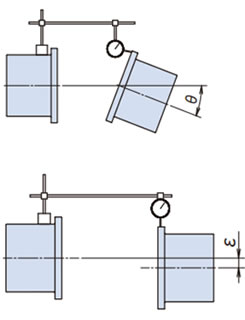
| Model No. | Recommended centering value | ||||
|---|---|---|---|---|---|
| Angular misalignment | Parallel misalignment ε[mm] |
Distance between flange faces J[mm] |
|||
| θ [deg] |
T.I.R. [mm] |
||||
| NER59W | 0.35 | 0.33 | 0.18 | ±0.5 | |
| NER93W | 0.35 | 0.39 | 0.22 | ±0.5 | |
| NER230W | 0.25 | 0.31 | 0.18 | ±0.5 | |
| NER360W | 0.25 | 0.36 | 0.22 | ±0.5 | |
| NER630W | 0.25 | 0.43 | 0.22 | ±0.5 | |
| NER850W | 0.25 | 0.48 | 0.25 | ±0.5 | |
| Model No. | Recommended centering value | ||||
|---|---|---|---|---|---|
| Angular misalignment | Parallel misalignment (formula ) ε[mm] |
Distance between flange faces J[mm] |
|||
| θ [deg] |
T.I.R. [mm] |
||||
| NER59W | 0.35 | 0.33 | (J-44.4)×0.31×10-2 | ±0.5 | |
| NER93W | 0.35 | 0.39 | (J-50.6)×0.31×10-2 | ±0.5 | |
| NER230W | 0.25 | 0.31 | (J-58.8)×0.22×10-2 | ±0.5 | |
| NER360W | 0.25 | 0.36 | (J-70.0)×0.22×10-2 | ±0.5 | |
| NER630W | 0.25 | 0.43 | (J-76.4)×0.22×10-2 | ±0.5 | |
| NER850W | 0.25 | 0.48 | (J-86.6)×0.22×10-2 | ±0.5 | |
Relationship between angular misalignment and parallel misalignment
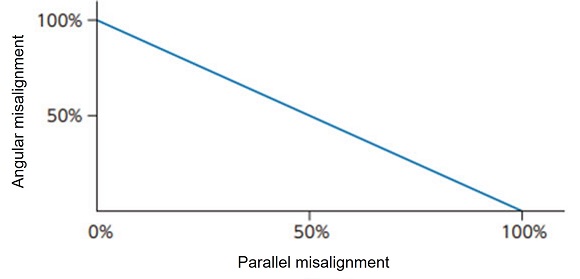
3. Installing center unit
- (1) Mount the center unit to the hubs after referring to the component drawing in the instruction manual.
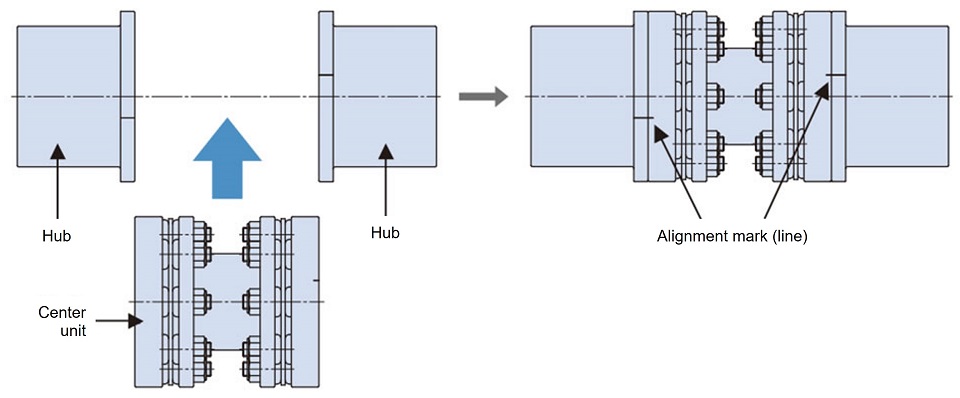
Fig. 1.Installing center unit
There are alignment marks (lines) on one side of the hub and center unit outer circumferences (one on each hub, two on the center unit).
Align the parts so that the marks align.
The center unit has no directionality, so can be mounted facing either right or left.
- (2) Fasten the hubs and center unit using the positioning bolts and hex socket head bolts.
When fastening the hubs and center unit, insert the positioning bolts (with green heads) into the drilled holes at the alignment marks (lines). The positioning bolts will not fit into other drilled holes.
There are two positioning bolts (with green heads) on each side, located 180 degrees apart. (There are a total of four positioning bolts per coupling. )
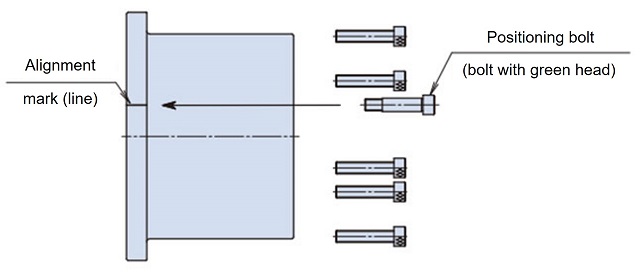
Fig. 2.Positioning bolt and hex cap bolt insertion
Be sure to tighten the positioning bolt and hex cap bolts to the torque specified in Table 3.
Table 3.Positioning bolt and hex cap bolt tightening torques Model No. Bolt size Tightening torque
[N・m]NER59W M6 14 NER93W M6 14 NER230W M6 14 NER360W M8 34 NER630W M10 67 NER850W M10 67 - (3) When you have assembled the coupling, remove the disk protective plates on the disks.
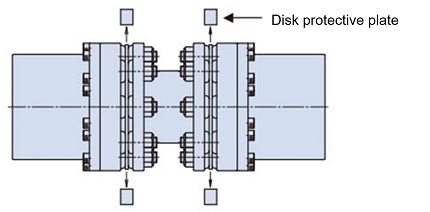
Four disk protective plates are attached (two on each disks).
4. Inspection
Re-check the angular misalignment and parallel misalignment one or two hours after starting actual operation.
After the check, refasten the positioning bolts and hex socket head bolts to the torque specified in Table 3.
Also check for problem parts or looseness in the positioning bolts and hex sock head bolts every 6 months to one year.
After installing the equipment, marking the positioning bolts, hex socket head bolts and hubs to enable checks for looseness is recommended.
Be sure to check for any abnormalities in other components as well.

